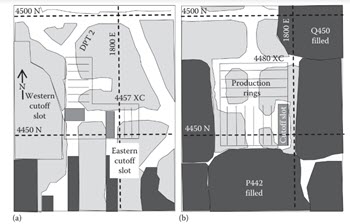Geotechnical mapping requires the determination of the number of families, location (frequency and spacing), orientation and size, intact rock strength, hydrological condition, and surface properties of critical discontinuities likely to influence stope stability. The information is usually recorded on a tabular data sheet suitable for subsequent computer analysis. The dimensions of the observation window, regardless of the mapping technique used, should be kept constant at each site and across sites, since data from different locations are usually grouped together.

Basic information at each site should include the number, location, elevation, bearing, and plunge of the reference line used to collect the frequency, the dip and dip direction of the rock exposure, and the censoring levels of the convex sampling window (up and down from the observation line; see Figures 4.22 and 4.23). A mnemonic system compatible with the notation used by the local geologists should be implemented to identify different rock types and discontinuity infill material at each site (Call et al., 1976). The following characteristics and geological factors influencing a rock mass should be recorded (for cell and line mapping techniques):
Distance along the tape where the discontinuity intersects the sampling line. Discontinuity spacing is calculated from intercept distances, the mean set orientation, and the orientation of the sampling line. Numerically, the individual apparent spacing values are defined by sorting the discontinuities by individual sets down the line and subtracting the distances between adjacent discontinuities of the same set.
End points of the discontinuities intersecting the tape. When the discontinuities are observed through a convex window, three set of observations are obtained: joints totally contained (two trace length end points observable), joints intersecting only one of the window boundaries (one trace length end point observable), and finally, joints transecting the window (no trace length end points observable).
Type of structures, naturally occurring features such as faults, shears, bedding, veins, joints, contacts, etc.
Orientation: dip and dip direction of features intersecting the tape.
Rock type recorded using a mnemonic system code.
Roughness: A qualitative measure of the small-scale (2 cm or less) asperities on the discontinuity surface. Rough, smooth, and slickensided categories are used.
Planarity: A qualitative indication of the geometrical nature of the discontinuities on a large scale. Planar, wavy, and irregular categories are used. The rock mass classification parameter joint roughness (Jr) is determined based on small-scale roughness and large-scale planarity. However, the guidelines for the classification of discontinuity joint roughness can be subjective due to the qualitative nature of their description. Milne et al. (1991) have developed a method that can be used to measure joint roughness quantitatively. Following Milne et al. (1991), small-scale roughness (Jrr) can be calculated by determining the maximum joint amplitude over a 10 cm profile, and the large-scale planarity (Jrw) can be calculated by establishing the maximum joint amplitude over a 1 m profile. These two parameters can be measured using a 10 cm steel rule and a 1 m folding rule, where each ruler is placed along the discontinuity surface, and the maximum amplitude is recorded for both 10 cm and 1 m profiles as shown in Figure 4.26. Small-scale amplitudes of less than 2.5 mm are assigned a Jrr of 1.0, while amplitudes greater than 2.5 mm are assigned a Jrr of 1.5. Similarly, the large-scale planarity Jrw is assigned values of 1.0, when the amplitudes measured are less than 10 mm, a value of 1.5 when the amplitudes measured fall between 10 and 20 mm, and finally a Jrw value of 2.0 is assigned to measured amplitudes greater than 20 mm. The resulting joint roughness (Jr) for classification purposes is determined by multiplying the Jrr and Jrw terms.
Infill material: In some discontinuities such as faults, this may be gouge and slickensides, and in others, it may be a quantitative mineralogical assemblage.
Thickness: The measured width across a discontinuity wall.
Alteration of the discontinuity walls, determined using scratching tests. Guidelines were suggested in Section 4.3.3.
Trace length measured as seen in the rock face. The trace length is the maximum measurable length of the resulting intersection between a discontinuity and a planar excavation in rock.
Termination as observed in the top and bottom of a discontinuity in the dip direction, but only if the discontinuity is contained; otherwise, the termination is artificially obscured by the observation window or the excavation geometry. Discontinuities can terminate either against another joint or within intact rock. Call et al. (1976) introduced the concept of high- (>20°) and low (<20°)-angle termination against another discontinuity; when this occurs, observations suggest that one of the discontinuities is likely to propagate further along a common direction (Figure 4.27).
Remarks are used to describe other characteristics such as alteration, observed hydrological conditions, etc.
The format of the geotechnical data collected must allow flexibility such that a geotechnical engineer can utilize any number of rock mass characterization or classification techniques as required. Therefore, the parameters collected should preferably describe engineering geology data, rather than interpreted rock mass classification parameters (Cepuritis, 2004). As an example, it is recommended to collect planarity and roughness data instead of an interpreted Jr from the Q system (Barton et al., 1974). It is very important to note that collecting fundamental engineering geology characteristics in the form of rock mass classification parameters may introduce bias, as these parameters are interpretations and simplifications of the actual rock mass characteristics. Appendix A shows the proposed data collection sheets for core logging and geotechnical mapping taking into account the 12 fundamental characteristics described later.



0 Comments